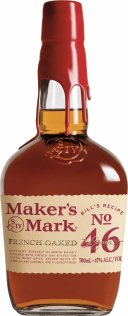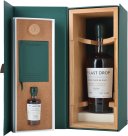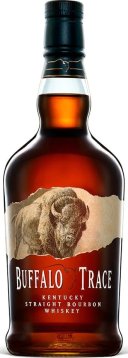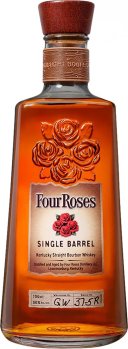Woodford Reserve Master's Collection Sonoma Triple Finish Bourbon Whiskey
Maker: In the 1830s the Woodford County distillery was the setting for a series of discoveries and innovative practices that would define the bourbon industry for generations to come. Today that pioneering and innovative tradition is embodied in the Woodford Reserve Distillery's Master's Collection. A tradition beginning when Master Distiller James Crow joined distillery owner Oscar Pepper to create the first true Kentucky bourbon whiskies. Distillery: The art of making fine bourbon first took place on the site of the Woodford Reserve Distillery, a National Historic Landmark, in 1812. You get that sense of history. The history of bourbon is the history of Kentucky, is the history of the United States. Distillers Chris Morris and Elizabeth McCall share the belief that the keys to making the World’s Finest Bourbon are not only time and patience, but science and art. There are five sources to Woodford Reserve's flavour grain recipe, water, fermentation, distillation, maturation. Woodford Reserve is crafted from a grain recipe of 72% corn, 18% Rye, and 10% malted barley. This recipe balances the sweetness of corn with the spice of rye, and the nuttiness of malt to build the base. The water used to craft Woodford Reserve comes directly from the distillery. It is naturally filtered by the limestone deposits under the property. Iron-free and mineral rich, it is a crucial ingredient in the process. The fermentation process is among the longest in the industry. This extra time, paired with our unique yeast strain, creates a great depth of character and a complex range of flavours. Woodford Reserve favours pot stills and column stills for a perfect balance of flavour. Finally, Woodford Reserve is matured in new, charred, white oak barrels made in house. The barrel is a key ingredient in the process, contributing flavour complexity, and balance. Winestyle/Cuvee: For this 2023 release, Master Distiller Elizabeth McCall has drawn upon prior creative releases and continued product experimentation for inspiration. In 2014, the Master’s Collection released the first Pinot Noir finished Kentucky Bourbon in history, Sonoma-Cutrer Pinot Finish. This was followed in 2016 with the first-ever American Brandy Cask finished Bourbon. The Pinot Noir and brandy barrels used for these releases were obtained from famous Sonoma County wineries. These releases featured big, bold, red and dried fruit flavors along with dark chocolate and baking spice notes. At the same time, many wineries began to age their red wines in used Woodford Reserve barrels to create a new “Bourbon Barrel Aged” genre. These wines featured rich vanilla and caramel notes. This inspired Elizabeth to experiment with various combinations of the three— including finishing Woodford Reserve in Sonoma County wine barrels that had originally been used to mature Woodford Reserve. The result, Sonoma Triple Finish, is a unique blend of Woodford Reserve Kentucky Straight Bourbon Whiskey that has been finished in Sonoma County Pinot Noir, Brandy, and former Bourbon barrels used to age red wine. Nose- Oak, New Leather, Cinnamon The scent of chocolate wafer crisps and caramel-covered Flan fills my nostrils. There’s a nice amount of oak and leather present too. Followed by creamed corn scent. Toasted pecans dusted with cinnamon and some cherries in the mix. Palate - Red Fruit, Vanilla Bean, Cedar Spice Sonoma Triple Finish is a rich, fruity, vanilla and spice-forward expression of Woodford Reserve Kentucky Straight Bourbon Whiskey. Finish - Char, Red Grape Tannins Long oak and red grape tannins, Sweet Spice
Maker's Mark 46 Kentucky Straight Bourbon Whiskey
Uniquely finished to deliver a more elevated experience, Maker’s 46 is aged longer with special seared French oak staves. With subtly layered bourbon notes and balanced complexity, 46 is the legacy of Bill Samuels, Jr., son of Maker’s Mark founders Bill and Margie. Released in 2010, Maker’s 46 was the first new major expression to be created at Star Hill Farm since classic Maker’s went into production in 1953. The first new bourbon since opening their doors had to make a statement. And Maker’s 46 did, as the first offering from the distilleries breakthrough wood-finishing series. Today, they continue to experiment with the effects of wood finishing to craft new expressions of Maker’s Mark, always remaining true to the original Maker’s – and the expertise, passion and persistence of Bill and Margie.
The Last Drop Distillers Release No. 28 Drew Mayville Signature Blend Kentucky Straight Whiskeys with Sample Non-Vintage
Buffalo Trace Bourbon Whiskey
For over 200 years, Buffalo Trace Distillery has been defined by a dedication to one craft: making fine American whiskey. By honouring tradition and embracing change, it has earned its place of leadership among the legendary spirits producers of the world and is now recognised as the World’s Most Awarded Distillery. The venture produces a wide range of whiskeys using three different mash bills: one light rye, one heavy rye and a third flavoured with wheat. They've developed different products by aging those three mash bills to meet various grades and price points. At Buffalo Trace, that translates into at least fifteen labels: W. L. Weller, Eagle Rare, George T.Stagg and Old Rip Van Winkle (amongst others), and that's not counting many reserve and limited-release variants. While the mash bills contribute to the flavour, the more significant differentiation among brands takes place in century-old warehouses. Constructed of massive wood beams and covered by a brick shell, these structures allow the alternating cooling and warming of Kentucky's four distinct seasons to mature the bourbon by nature's timetable. Steam pumped throughout the warehouses during the extreme cold of winter compensates for the dramatic drops in temperature and gives the whiskey additional cycles in and out of the wood. This is said to make for a more balanced bourbon as the liquid is able to take additional advantage of the natural sugars occurring in the charred barrels. The distillery was the first to use this method of aging in 1859 and has been doing so ever since. The warehouses were built in the 1900s and represent diverse architectural styles. Consequently, their designs and location on the property contribute to the significant differences in the whiskey coming from each. Certain floors within a given warehouse produce better whiskey than others do. For example, the fourth and fifth floors of Warehouse C and the fourth through sixth floors of Warehouses I and K produce the company's best. It's these locations which have been reserved for the maturation of Buffalo Trace. The brand itself was born only relatively recently. In 1999, visitors to the newly named and renovated distillery asked, “Why isn’t there a bourbon called ‘Buffalo Trace?" In response, Elmer T. Lee ventured into the best floors in the best warehouses to find some of the finest barrels that really matched up with his views on what a full-bodied, robust Kentucky straight bourbon whiskey should taste like. The result was what consumers enjoy today , batched from no more than 40 barrels at a time. There are two ABV variants on offer - one at 45% and this lower proof 40% bottling. The flavour profiles are pretty much identical, but as you would expect, less alcohol means a little less concentration. That said, the difference isn't huge, and what you miss out on is made up for in dollar savings. The style moves away from macho Bourbon, aligning with the feminine elegance of whiskeys like Evan Williams Single Barrel. As an affordable, middle-tier offering, it's also deceptively complex. The rye is evident but balanced by softer, sweeter notes like vanilla wafers, toasted sponge cake, cherry chocolate and just plain old, high-quality American oak. This expression doesn't boast super length, but it is incredibly easy to drink. Our preference is uncut (too much water makes it a little 'peachy' and the more nuanced notes are lost). An ice cube and a comfortable chair by the barbeque is all you need to complete the picture.
Jim Beam White Label Bourbon Whiskey
Originated in the 1780s by Jacob Beam, a Kentucky farmer, who operated a grain mill and ground grist for locals - a portion of which was always reserved for the families private use - to make whisky. It was in 1795 the Jacob finally began commercial production, however it was not under the Beam Label. Consistency of style has been maintained by using the same yeast cultures for over 60 years, derived from an original culture made by Jim Beam himself on his back porch. Beam Bourbon is the product of six generations of distillers with only one enforced break in production between 1920 and 1933 when prohibition was introduced to the U.S. It was following prohibition, (during which time the distillery had been shut and sold to the U.S. government) that the bourbon was named "Jim Beam" after the head of the Beam family. To drink Beam then is to taste something of its American heritage. White Label is aged for four years and appreciated for it's pleasant sweet/sour and mellow, nutty character, making it one of the biggest selling Bourbons globally. 37% alc./vol.
Noah's Mill Strength Bourbon Whiskey
Note: ABV may vary from batch to batch. Tasting note: [BATCH QBC 16-25 tasted] Bright brassy copper. Dessert style opening sniffs include tea biscuits, vanilla fudge, mocha and hints of sticky date. Air contact dries and lightens the bouquet introducing liquorice root, and fresher, woody/peppery notes. Linear on entry. Mid palate is mildly bittersweet, bolder, oily, resinous, plummy, warming but keenly balanced at high ABV. Finishes with a brisk flurry of sweet baking spices and late cedary oak. 57.15% Alc./Vol.
Four Roses Single Barrel Bourbon Whiskey
"...you can buy me a dozen of these roses any day of the week." - breakingbourbon.com Produced from a mashbill of 60% corn, 35% rye, and 5% malted barley, the strain of yeast used for the Single Barrel bottlings is Four Roses' version “V” which is described as being "delicately fruity, spicy, and creamy." (The distillery is unique in that it uses five different strains to create ten different whiskies). Ages will vary in this series, (a seven year minimum is cited by one source). Regardless, the aim is to bottle when the whiskeys are deemed to have reached their peak, with each barrel yielding approximately 180 bottles. Each release is individually marked with a warehouse and barrel number which is not predictable and subject to change without notice. It's also part of the fun: No two barrels create identical tasting Bourbons, thus the single barrel concept provides the opportunity to appreciate and compare whiskies from different barrels and aging locations. [Barrel RN 8-4R tasted] Bright burnished copper penny colour. A robust Bourbon sniff with a dense core of vanilla custard and caramel fudge overlaid with peppermint, balsa wood, cocoa and hints of cherry. Concentrated yet controlled with razor sharp sweet/dry balance; a burst of vanillan oak, honey and spiced peach, offset by a tangy, vibrant finish. Glace cherry is followed by late mint freshness. Text-book poise and length. As complete a Bourbon as you could expect to find in its category, this really over delivers. 50% Alc./Vol.









